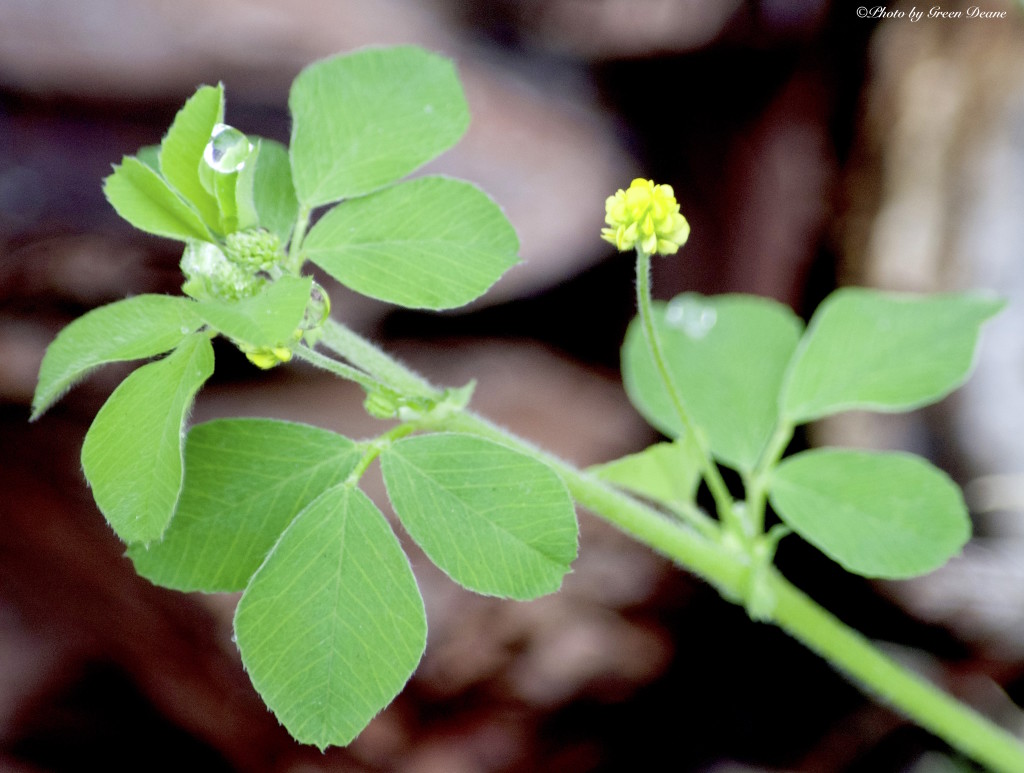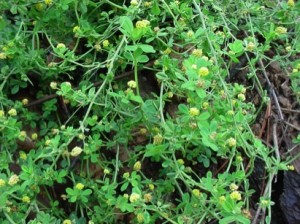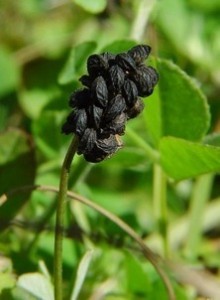Medicago Lupulina: Grain and Potherb
I debated a long time whether to include Black Medic as an edible. There are several plants in that category and over time I usually land on one side or the other. Black Medic is one of them.
Black Medic itself has not been implicated in any disease that I currently know of. But one of its relatives and at least one chemical it contains has. Not exactly a smoking gun but where there is warmth there might be fire.
Black Medic is a species in the Medicago genus. Some Medicagos (Alfalfa for example) might present a health risk because they have L-canavanine. It’s an amino acid which can cause abnormal blood cell counts, spleen enlargements, or a recurrence of lupus in those who had the disease under control. Seeds and sprouts have more L-canavanine than leaves or roots. One qualifier: Heated alfalfa did not appear to cause any problems, and the thinking is heating the L-canavanine destroys its potential toxic activity. The seeds of the Black Medic might also contain trypsin inhibitors that could reduce nutritional qualities. Sprouting the seeds might eliminate that purported problem. It’s all rather iffy.
Alfalfa also has some estrogenic components, so it is not recommended for pregnant women or children, and it also increases the clotting ability of your blood, or decreases the effectiveness of such drugs as Warfarin/Coumadin. Lastly Alfalfa sprouts can appear fresh yet contain a multitude of bacteria so they are not recommended for children, those with chronic disease, or the elderly. It would seem cooking the Medicago genus is a good idea. So, if you are a healthy young man you might be able to eat a Medicago now and then and be none the worse for it. But what about Black Medic? The answer is no one really knows.
A report that California Indians used to eat the seeds of the Black Medic is a curious one. They parched them or ground them into a flour. The seeds can be beaten off ripe inflorescences over a sheet or the like to collect them. In Eurasia, where the plant is native, it was used as a potherb. Black Medic is first mentioned in the early United States in a seed catalog in Pennsylvania in 1807. The plant went west with the expansion of the nation. Oddly there seems to be no mention of the Indians eating it as a potherb (they only ate the seeds) nor any mention of Eurasians eating the seeds (they only ate the foliage.) Need could dictate that, poor record keeping, wrong questions asked, or how the plant was being used the day the chronicler visited.
According to the well-known Dr. James Duke (Medicinal Plants of China) nutritionally the leaves of the Black Medic are rather high in protein for a green. Three ounces has about 23.3 grams of protein, 3.3 of fiber and 10.3 of ash. In milligrams they have 1330 mg of calcium, 300 mg of Phosphorus, 450 mg of magnesium and 2280 mg of potassium.
Botanically the Black Medic is Medicago lupulina. Medicago (med-ik-KAY-goh) is Greek bastardized through Dead Latin. Some say the Greeks imported a grass (alfalfa) from Media (Persia now Iran.) Some say the Medes brought it with them when they invaded Greece. Regardless the Greeks called it “median grass” which in Greek is μηδική (said mee-thee-KEE.) The Romans’ called it Medica. That got botanized into Medicago when combined with agere, to bring.
Lupulina is Latin for “little wolf. Origin of the term is a bit contorted. The Black Medic blossom resembles Hops (Humulus lupulus which means “low wolf.” That hops in Germany often climbed on the Willow Wolf Tree, Lupus silicarius (wolf with silica.) That double hint towards lupus ended up Lupulina.
Green Deane’s “Itemized” Plant Profile: Black Medic
IDENTIFICATION: Medicago lupulina: Multi-branched, slender, prostrate, slightly hairy stems, 12 to 24 inches long, spreads low to the ground, does not root from nodes. Leaflets of three, center leaflet on separate petiole and longer than other two. Resembles hop clover but has longer leafstalk, leaflets often bristle-tipped. Tightly coiled one-seed black pod. Re Black Medic and Hop Clover: Stems of M. lupulina are downy (they have white hairs.) The stems of Trifolium. dubium are almost hairless and more reddish.
TIME OF YEAR: Flowers April to August, seeds ripen July to September. Not frost tender.
ENVIRONMENT: Roadsides, waste areas.
METHOD OF PREPARATION: Seeds parched and or ground into flower. Leaves as a potherb. Chewy. Should be cooked.




